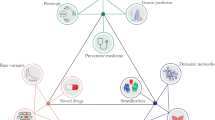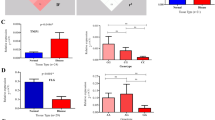Abstract
Psoriasis is an immune-mediated skin disorder, which is inherited as a complex trait. Genome-wide linkage and association studies have identified a major disease susceptibility locus on chromosome 6p21, as well as a number of genetic determinants of smaller effect. Our group has also documented a significant association between psoriasis and CDKAL1, a gene previously implicated in the pathogenesis of Crohn's disease (CD) and type II diabetes (TIID). With this study, we validate this association, through the analysis of CDKAL1 single nucleotide polymorphism (SNP) rs6908425 in an independently ascertained psoriasis dataset (replication sample: 1323 cases vs 1368 controls, P=0.00012, odds ratio (OR): 1.28; combined sample: 2579 cases vs 4306 controls, P=4 × 10−6, OR: 1.26). We also show that the association with psoriasis and CD is completely independent from that with TIID. Finally, we report the results of expression studies demonstrating that CDKAL1 transcripts are virtually absent from skin keratinocytes, but are abundantly expressed in immune cells, especially in CD4+ and CD19+ lymphocytes. It is to be noted that our data indicate that CDKAL1 becomes markedly downregulated when immune cells are activated with proliferating signals. Taken together, our results document the presence of allelic heterogeneity at the CDKAL1 locus and suggest that CDKAL1 alleles may confer susceptibility to clinically distinct disorders through differential effects on disease-specific cell types.
This is a preview of subscription content, access via your institution
Access options
Subscribe to this journal
Receive 6 digital issues and online access to articles
$119.00 per year
only $19.83 per issue
Buy this article
- Purchase on Springer Link
- Instant access to full article PDF
Prices may be subject to local taxes which are calculated during checkout

Similar content being viewed by others
Accession codes
References
Griffiths CE, Barker JN . Pathogenesis and clinical features of psoriasis. Lancet 2007; 370: 263–271.
Lowes MA, Bowcock AM, Krueger JG . Pathogenesis and therapy of psoriasis. Nature 2007; 445: 866–873.
Capon F, Munro M, Barker J, Trembath R . Searching for the major histocompatibility complex psoriasis susceptibility gene. J Invest Dermatol 2002; 118: 745–751.
Nair RP, Stuart PE, Nistor I, Hiremagalore R, Chia NV, Jenisch S et al. Sequence and haplotype analysis supports HLA-C as the psoriasis susceptibility 1 gene. Am J Hum Genet 2006; 78: 827–851.
Veal CD, Capon F, Allen MH, Heath EK, Evans JC, Jones A et al. Family-based analysis using a dense single-nucleotide polymorphism-based map defines genetic variation at PSORS1, the major psoriasis- susceptibility locus. Am J Hum Genet 2002; 71: 554–564.
Capon F, Bijlmakers MJ, Wolf N, Quaranta M, Huffmeier U, Allen M et al. Identification of ZNF313/RNF114 as a novel psoriasis susceptibility gene. Hum Mol Genet 2008; 17: 1938–1945.
Capon F, Di Meglio P, Szaub J, Prescott NJ, Dunster C, Baumber L et al. Sequence variants in the genes for the interleukin-23 receptor (IL23R) and its ligand (IL12B) confer protection against psoriasis. Hum Genet 2007; 122: 201–206.
Cargill M, Schrodi SJ, Chang M, Garcia VE, Brandon R, Callis KP et al. A large-scale genetic association study confirms IL12B and leads to the identification of IL23R as psoriasis-risk genes. Am J Hum Genet 2007; 80: 273–290.
de Cid R, Riveira-Munoz E, Zeeuwen PL, Robarge J, Liao W, Dannhauser EN et al. Deletion of the late cornified envelope LCE3B and LCE3C genes as a susceptibility factor for psoriasis. Nat Genet 2009; 41: 211–215.
Nair RP, Duffin KC, Helms C, Ding J, Stuart PE, Goldgar D et al. Genome-wide scan reveals association of psoriasis with IL-23 and NF-kappaB pathways. Nat Genet 2009; 41: 199–204.
Zhang XJ, Huang W, Yang S, Sun LD, Zhang FY, Zhu QX et al. Psoriasis genome-wide association study identifies susceptibility variants within LCE gene cluster at 1q21. Nat Genet 2009; 41: 205–210.
Duerr RH, Taylor KD, Brant SR, Rioux JD, Silverberg MS, Daly MJ et al. A genome-wide association study identifies IL23R as an inflammatory bowel disease gene. Science 2006; 314: 1461–1463.
Burton PR, Clayton DG, Cardon LR, Craddock N, Deloukas P, Duncanson A et al. Association scan of 14 500 nonsynonymous SNPs in four diseases identifies autoimmunity variants. Nat Genet 2007; 39: 1329–1337.
Plenge RM, Cotsapas C, Davies L, Price AL, de Bakker PI, Maller J et al. Two independent alleles at 6q23 associated with risk of rheumatoid arthritis. Nat Genet 2007; 39: 1477–1482.
Graham RR, Cotsapas C, Davies L, Hackett R, Lessard CJ, Leon JM et al. Genetic variants near TNFAIP3 on 6q23 are associated with systemic lupus erythematosus. Nat Genet 2008; 40: 1059–1061.
Fung EY, Smyth DJ, Howson JM, Cooper JD, Walker NM, Stevens H et al. Analysis of 17 autoimmune disease-associated variants in type 1 diabetes identifies 6q23/TNFAIP3 as a susceptibility locus. Genes Immun 2009; 10: 188–191.
Hunt KA, Zhernakova A, Turner G, Heap GA, Franke L, Bruinenberg M et al. Newly identified genetic risk variants for celiac disease related to the immune response. Nat Genet 2008; 40: 395–402.
The Wellcome Trust Case-Control Consortium. Genome-wide association study of 14 000 cases of seven common diseases and 3000 shared controls. Nature 2007; 447: 661–678.
Wolf N, Quaranta M, Prescott NJ, Allen M, Smith R, Burden AD et al. Psoriasis is associated with pleiotropic susceptibility loci identified in type II diabetes and Crohn disease. J Med Genet 2008; 45: 114–116.
Scott LJ, Mohlke KL, Bonnycastle LL, Willer CJ, Li Y, Duren WL et al. A genome-wide association study of type 2 diabetes in Finns detects multiple susceptibility variants. Science 2007; 316: 1341–1345.
Steinthorsdottir V, Thorleifsson G, Reynisdottir I, Benediktsson R, Jonsdottir T, Walters GB et al. A variant in CDKAL1 influences insulin response and risk of type 2 diabetes. Nat Genet 2007; 39: 770–775.
Zeggini E, Weedon MN, Lindgren CM, Frayling TM, Elliott KS, Lango H et al. Replication of genome-wide association signals in UK samples reveals risk loci for type 2 diabetes. Science 2007; 316: 1336–1341.
Li Y, Liao W, Chang M, Schrodi SJ, Bui N, Catanese JJ et al. Further genetic evidence for three psoriasis-risk genes: ADAM33, CDKAL1, and PTPN22. J Invest Dermatol 2009; 129: 629–634.
Purcell S, Neale B, Todd-Brown K, Thomas L, Ferreira MA, Bender D et al. PLINK: A tool set for whole-genome association and population-based linkage analyses. Am J Hum Genet 2007; 81: 559–575.
Li Y, Ding CJ, Abecasis G . Mach 1.0: Rapid haplotype reconstruction and missing genotype inference. Am J Hum Genet 2006; 79: S2290.
Purcell S, Cherny SS, Sham PC . Genetic power calculator: Design of linkage and association genetic mapping studies of complex traits. Bioinformatics 2003; 19: 149–150.
Livak KJ, Schmittgen TD . Analysis of relative gene expression data using real-time quantitative PCR and the 2(-Delta Delta C(T)) Method. Methods (San Diego, California) 2001; 25: 402–408.
Seldin MF, Amos CI . Shared susceptibility variations in autoimmune diseases: A brief perspective on common issues. Genes Immun 2009; 10: 1–4.
Barrett JC, Hansoul S, Nicolae DL, Cho JH, Duerr RH, Rioux JD et al. Genome-wide association defines more than 30 distinct susceptibility loci for Crohn's disease. Nat Genet 2008; 40: 955–962.
Pascoe L, Tura A, Patel SK, Ibrahim IM, Ferrannini E, Zeggini E et al. Common variants of the novel type 2 diabetes genes CDKAL1 and HHEX/IDE are associated with decreased pancreatic beta-cell function. Diabetes 2007; 56: 3101–3104.
Anderson CA, Massey DC, Barrett JC, Prescott NJ, Tremelling M, Fisher SA et al. Investigation of Crohn's disease risk loci in ulcerative colitis further defines their molecular relationship. Gastroenterology 2009; 136: 523–529 e3.
Lee FI, Bellary SV, Francis C . Increased occurrence of psoriasis in patients with Crohn's disease and their relatives. Am J Gastroenterol 1990; 85: 962–963.
Yates VM, Watkinson G, Kelman A . Further evidence for an association between psoriasis, Crohn's disease and ulcerative colitis. Br J Dermatol 1982; 106: 323–330.
Visel A, Minovitsky S, Dubchak I, Pennacchio LA . VISTA Enhancer Browser--a database of tissue-specific human enhancers. Nucleic Acids Res 2007; 35: D88–D92.
Acknowledgements
We thank Massimo Mangino for his contribution to the statistical analyses and John Mee for providing access to primary keratinocytes. Funding support for the CASP study was provided by the National Institutes of Health and the genotyping of samples was implemented through the Genetic Association Information Network (GAIN). Samples and associated phenotype data for the CASP study were provided by Goncalo Abecasis. We acknowledge the use of genotype data from the British 1958 Birth Cohort DNA collection, funded by the Medical Research Council (grant G0000934) and The Wellcome Trust (grant 068545/Z/02). This work was also supported by a PhD studentship from The Psoriasis Association (MQ) and grants from the British Skin Foundation (FC) and the Medical Research Council (JNB, RCT). Funding: British Skin Foundation, The Psoriasis Association, Medical Research Council
Author information
Authors and Affiliations
Corresponding author
Additional information
Supplementary Information accompanies the paper on Genes and Immunity website (http://www.nature.com/gene)
Rights and permissions
About this article
Cite this article
Quaranta, M., Burden, A., Griffiths, C. et al. Differential contribution of CDKAL1 variants to psoriasis, Crohn's disease and type II diabetes. Genes Immun 10, 654–658 (2009). https://doi.org/10.1038/gene.2009.51
Received:
Accepted:
Published:
Issue Date:
DOI: https://doi.org/10.1038/gene.2009.51
Keywords
This article is cited by
-
Exploring the molecular mechanism underlying the psoriasis and T2D by using microarray data analysis
Scientific Reports (2023)
-
Psoriasis and Cardiovascular Risk: A Comprehensive Review
Advances in Therapy (2020)
-
Systematic evaluation of validated type 2 diabetes and glycaemic trait loci for association with insulin clearance
Diabetologia (2013)
-
Twelve type 2 diabetes susceptibility loci identified through large-scale association analysis
Nature Genetics (2010)



